The Mandalorian: Season 3 Case Study

Case Study
Image Engine continues to build out Disney’s new vision for Star Wars on The Mandalorian season three – a vision the studio has contributed to since the show's first season. Read on to discover how the team delivered yet another 687 stunning shots for the adventures of Din Djarin, Grogu, and Bo-Katan.
View portfolio page Watch breakdown reelIn the world of modern television, few series have revolutionized what’s possible on the small screen quite like The Mandalorian. Now entering its third season, the iconic Star Wars series has embarked on another ambitious journey through the galaxy far, far away, continuing to tell the visually dazzling story of the eponymous bounty hunter Din Djarin, his adopted son Grogu, and their adventures with fellow Mandalorian Bo-Katan Kryze as they battle to reclaim their lost home of Mandalore.
Image Engine is no stranger to the series or its world, having already contributed to The Mandalorian seasons one and two (not to mention The Book of Boba Fett, Obi-Wan Kenobi, and Ahsoka). The team gladly came on board once again for season three, this time taking on 687 shots across six episodes, including planetary environments, alien cyborgs, and a range of other visual effects ranging in complexity, scope, and required expertise.
“This was a big show for us, and the third biggest we’ve worked on at Image Engine,” remembered Cara Davies, VFX Producer. “We had a lot of different types of work required across the 687 shots, each with its own set of challenges to figure out and resolve. The size of the show and its complexity required all of us, from leadership to artists, to step up our game so we could deliver a product we were proud of – on time and within budget. Everyone on the team certainly rose to the challenge! I couldn’t have asked for a more professional, creative, and fun team to work with on this show.”
Read on to learn how Image Engine’s intricate artistry, technical prowess, and creative vision came together to deliver a third season of The Mandalorian that immersed and engaged viewers worldwide.
Heading to the Mines of Mandalore
In Chapter 18 of The Mandalorian, The Mines of Mandalore, audiences watch as Din flies to the Mandalorian’s home planet to ascertain if the atmosphere is non-toxic. After his R5 unit goes missing, Din scouts ahead into the mines, where a heavy-duty “Spider Mech” exoskeleton, bristling with weapons and claws, captures him. Piloting the exoskeleton is a cyborg “Crone Mech” – a skeletal, sinewy creation, part flesh, part piping with porcupine-like spines extruding from its back and a single, magnified eye glaring from its faceplate.
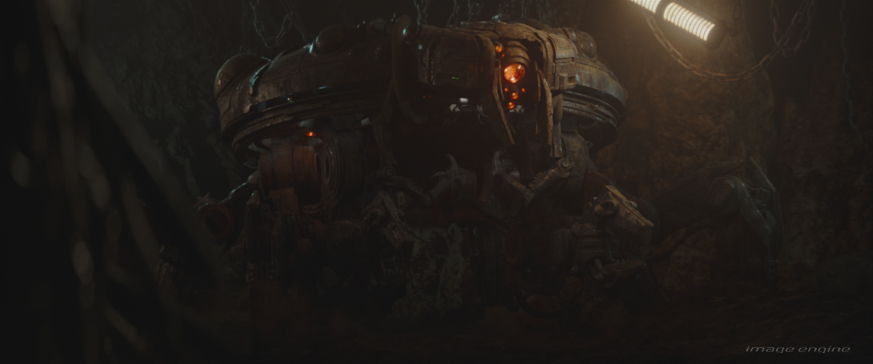
Image Engine supported the creation of this cyborg, its vehicle, and its ultimate demise at the hands of Bo-Katan, who comes to Djarin’s rescue and slashes through the Crone Mech with her black-bladed Darksaber.
“The sequence brief called for a creepy atmosphere, referencing Phill Tippet’s stop-motion horror Mad God and the Terry Gilliam film Brazil,” says Cara. “I think the team managed to execute that well – the moment where the Spider Mech first grabs Mando still makes me jump, even though I’ve watched it many times!”
The entire sequence required an extensive range of visual effects from Image Engine, necessitating full-CG work, environment extensions, and a lot of replacements, given that the cyborg was represented on-set by an actor in heavy make-up.
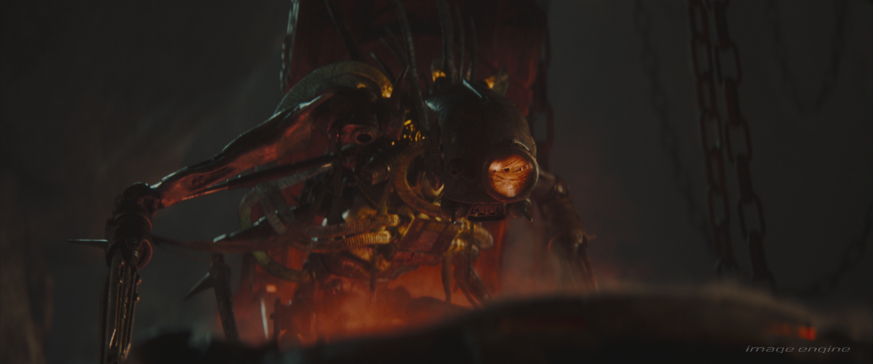
“Regarding the Spider-Mech, that was a practical asset created on set, but the production hadn’t designed it to articulate or move the way required for the shots assigned to us, so we had to recreate it in CG,” says Barry Poon, Head of Assets. “We received scans of the practical asset and used them to create two digital versions, including a damaged version that appears later in the sequence when Bo-Katan slices through the chassis.”
Next came the Spider-Mech’s animation, courtesy of Animation Supervisor Matt Kowaliszyn and his team. “The desired look for the Spider Mech’s locomotion was to emulate a large, clunky piece of machinery – like a backhoe with all the grace of a garbage truck – which meant lots of weight and jerky motions,” says Matt.
“For the fight with the Spider Mech, we created some early storyboard stills to pitch for the action. These storyboards were a good way to get buy-off on the fight’s action beats and help editorial lock in an early edit. I’m pleased the fight’s final version adhered closely to the initial picture-in-picture storyboards.”
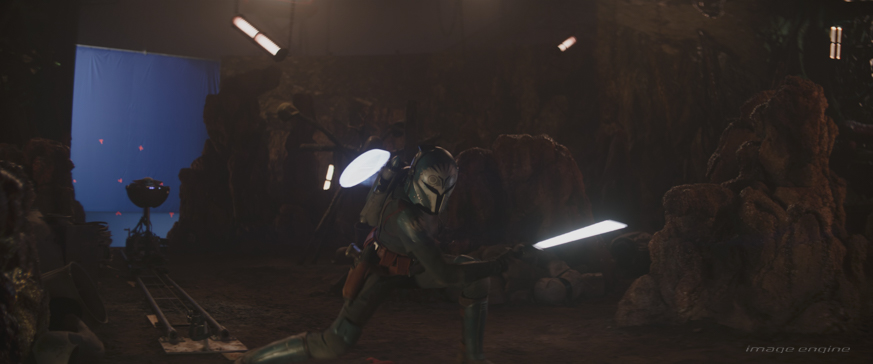
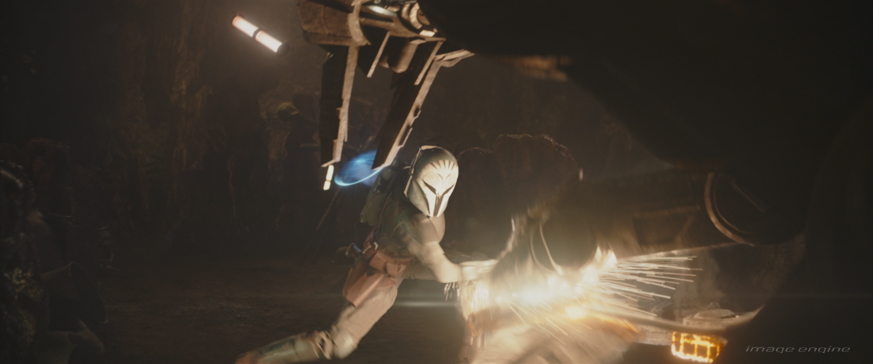
Next, Matt and his team turned their attention to the Crone Mech performance and fight, which also required a discovery process to lock in the creature’s movement. “The Crone Mech also needed to feel ancient and rickety – the walk was slow and resembled that of an old man, with an added creepiness factor – along with a touch of General Grievous,” says Matt. “However, despite its shaky movements, the Crone Mech also needed to be able to burst out with quick motions that kept it threatening. For example, when the character emerges from the Spider Mech in its initial reveal, we decided it would be creepiest for the Crone Mech to land on all fours and transition to a bipedal movement to keep audiences guessing what the character is capable of. Similarly, in the fight with Bo-Katan, we needed to show that the character could move fast and pose a challenge for the Mandalorian – until she recovers the Darksaber, that is!”
The Crone Mech’s singular eye lens is one of the more unforgettable aspects of the character. The eye, encased within its magnified eyepiece, emanates a spectrum of emotions – from fury to dread – and even wordlessly communicates the Crone Mech’s eventual demise as the life ebbs from its body. Edmond Engelbrecht, CG Supervisor at Image Engine, paid significant attention to this eye to ensure it felt real and emotive to audiences at home.
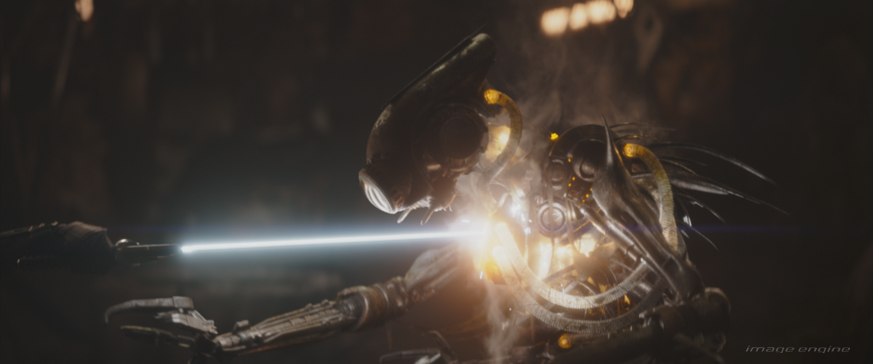
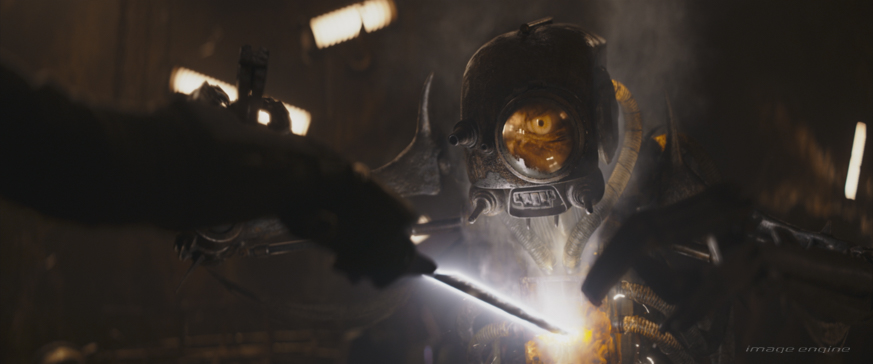
“The production was very receptive to us putting effort into replicating the physical world rather than just cheating for art direction, which was good because I was on a mission to make the Crone Mech’s eye as realistic as possible by building a physical micro fresnel lens!” says Edmond. “I called on Image Engine’s Houdini guys to help build the curve profile, which took some trial and error in testing the refraction until it looked just right.”
Lighting also played an essential role in emphasizing the scene’s overall dark and ominous atmosphere. “We enjoyed researching the colourful lighting scenarios common with 80s films as this sequence was inspired by Phil Tippet’s Mad God. I remember putting a hero shot of the Mech together with a Mad God style logo with the words, “Mad Mek,” on it to check if it fits the style. After riffing around some white smoke ideas with Robin, he suggested red smoke and it immediately became obvious that this was the right palette for the shots,” says Edmond. “The hanging practical lights in the sequence posed quite the management job for lighting to figure out the changes happening per shot but we felt we had the basis to dial them all in.”
“Another interesting aspect we considered were the chains hanging from the roof of the mine,” he continues. “I remember being inspired by shots from Alien, where the Xenomorph hangs among the dangling chains in the Nostromo’s cargo bay. We built a setup for these chains that complimented the animation, where the Spider Mech could walk into chains and jangle them as it fights. It’s a small thing, but it absolutely adds to the creepy atmosphere and helps demonstrate scale.”
The culmination of Image Engine’s craft is a sequence that is as chilling as it is thrilling, vividly rendered via visual effects. “The Mines of Mandalore sequence was challenging, but the results look great,” says Cara. “The CG characters sit well in the plate, and the nuances the team created really add to the creepiness of the whole scene.”
On the surface of Coruscant
Chapter 19 of The Mandalorian, titled The Convert, sees the pardoned Imperial scientist Dr. Pershing from previous seasons of the show now working for the New Republic on Coruscant, the galaxy’s capital. Supporting Pershing in his efforts is the shady Elia Kane, a (supposedly) former Imperial communications officer who has agreed to assist the doctor in continuing his outlawed cloning research. In one scene, the pair head to Coruscant’s Monument Plaza, where Umate – the only uncovered mountain on the ecumenopolis – protrudes from the slick metal cityscape.
Image Engine was responsible for the creation of this environment, including its holographs, street performers, CG crowds, and towering skyscrapers, as well as several other Coruscant environments witnessed throughout the episode, such as a train station interior and the docks leading up to it.
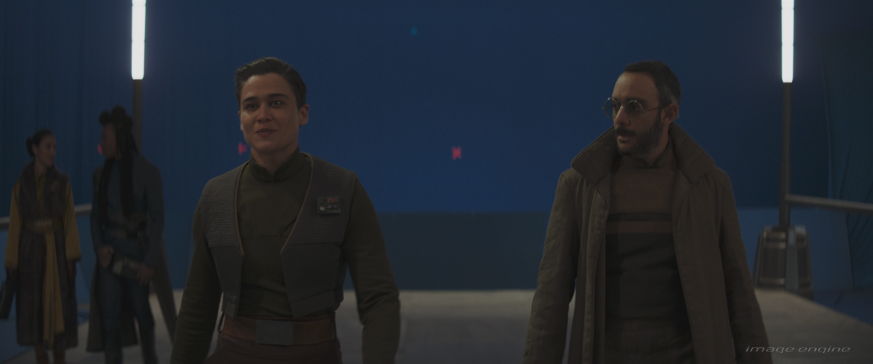
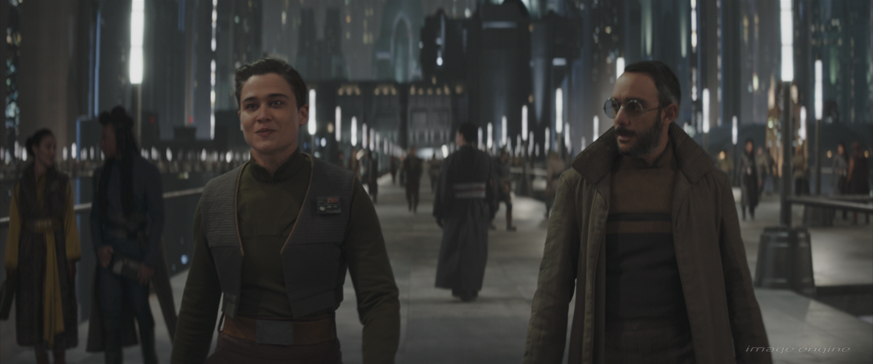
“Coruscant, whose city covers almost all of the planet’s entire surface, has a distinct style and building design developed over many years, so staying true to its design and style was critical,” says Ryan Woodward, CG Supervisor. “To ensure we matched the established design, we worked closely with the artwork and designs provided by the ILM team.”
For Monument Plaza, Image Engine received plates shot on the ILM Stagecraft™ volume, with a version of the Plaza already present. Image Engine’s brief was to enhance what was there and introduce additional elements to bring the plaza to life, such as juggling droids, a magician revealing a baby Woorst Rooster, and packed crowds of Coruscant citizens.
“The baseline from the production was that they had this big, long sequence in Monument Plaza shot on the LED volume stage – however, what the production couldn’t shoot on the volume stage was the liveliness of the environment,” says Robin Hackl, VFX Supervisor. “There needed to be thousands of people, as Coruscant has a population of a trillion. So the production enlisted us to add characters and crowds, which meant tracking every shot and adding digital backdrop characters. There was a lot of extensive crowd work required, and we did a lot of crowd generation and pre-generated caches.

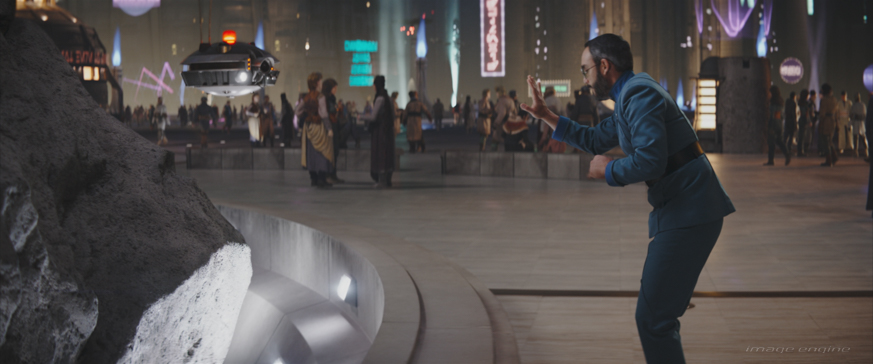
“Thrown into the mix was a big establishing shot, where we have a bird’s-eye view flying around this plaza and taking it all in,” continues Robin. “We had to ensure we had a CG asset that covered us for both that wide shot and all the supplemental shots that took place within it.”
Alongside the characters, Image Engine’s compositing team also added various holograms and signs to liven up the area and give more interest to the shots. “The compositing team designed and created the ad signs, with sign-off from the production team,” says Robin. “They thought through what the shape should be, what would be on the signs, such as how to use the Star Wars alphabet.”
Image Engine also worked on Umate – the mountain pinnacle that protrudes through the manufactured Coruscant surface and the planet’s only natural feature exposed to natural air. “The production originally shot Umate in the volume, but on close inspection, the mountain didn’t hold up to scrutiny,” says Robin. “To remedy this, we recreated the rock as a standalone asset that could withstand close-up hero shots.”
For the Plaza’s surrounding skyscrapers, Image Engine received assets of several futuristic, high-tech buildings, elaborated on their designs to ensure they held up in certain shots, and laid them out around the environment. “There were a few assets we had to upgrade and elaborate on so they would withstand scrutiny whenever the camera is closer,” says Robin.
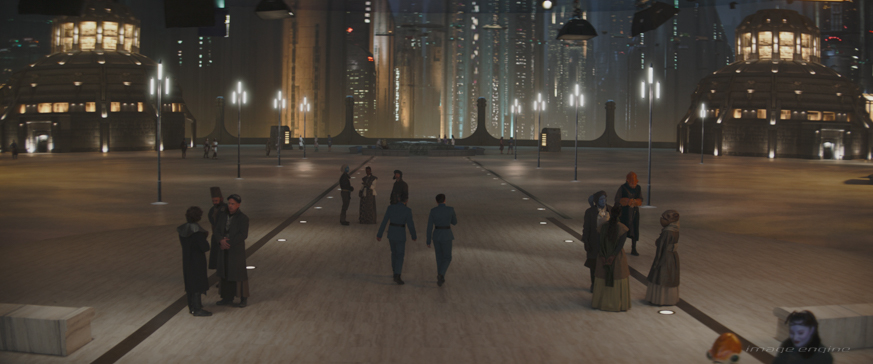
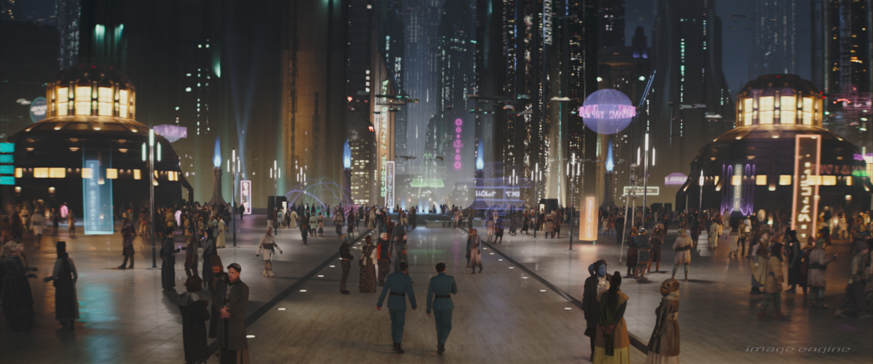
The result is a stunning nighttime rendition of a planet Star Wars fans have come to know very well indeed while showing a different, more cultural side of the ecumenopolis, removed from Coruscant’s usual politics and drama.
“Adding elements into an already shot volume screen comes with many challenges, ranging from matchmove to compositing. Nevertheless, watching the scene and knowing how much work the team put into it is seriously impressive,” says Robin. “All the disparate elements we worked on came together to create a truly delightful, carnival-like atmosphere. It really comes across in the final shots.”
The Dark Side of Coruscant
Later on, in Chapter 23 of The Mandalorian, aptly titled The Spies, an opening scene unfurls in a murky Coruscant back alley. The scene reveals that Elia Kane remains an undercover Imperial agent, diligently serving Moff Gideon as she covertly relays vital information regarding the Mandalorians’ intent to retake their home planet.
This scene posed a different take on Coruscant – one far removed from the previous joyful, carnival atmosphere. “The production intended the sequence to portray the seedier size of Coruscant, so it’s no surprise that Blade Runner‘s Los Angeles was one of our references, alongside references to Japanese and Korean alleyways with that Blade Runner look,” says Edmond. “Using those references as a base, we built the environment with a cyberpunk feel, adding elements such as a mizzle of rain and some steam, which we referenced from New York steam chimneys. The FX department did a pretty awesome job in bringing that together.”
Various holographic signs around the environment bathe the scene in a squalid neon light. As with Monument Plaza, the compositing team once again created these signs. “Working alongside the lighting team, we ensured the light cast by the holographic signs lit the environments with the right mood and did things like create believable reflections,” says Gabriel Pires, Compositing Supervisor.
The back alley scene develops as an Imperial probe droid emerges from the shadows above. Initially portrayed by a practical droid on set, Image Engine replaced this prop with a digitally rendered counterpart for the final shots.
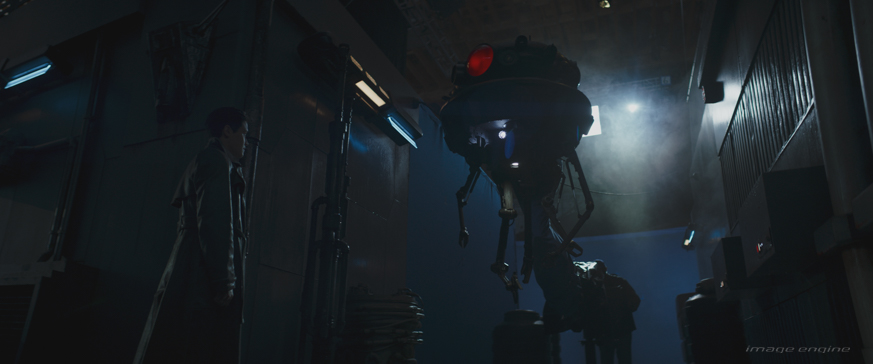
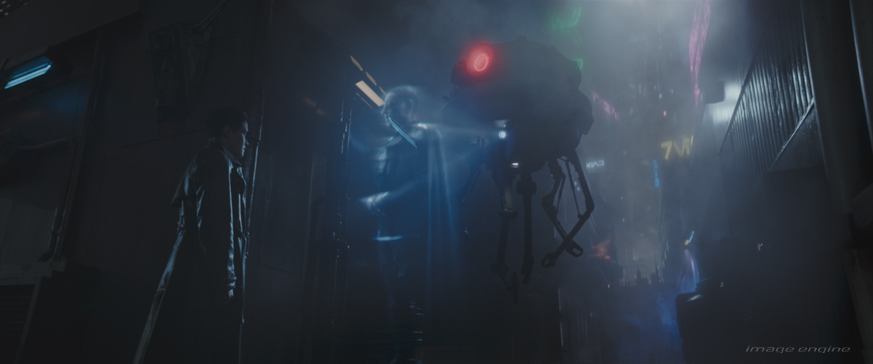
Once settled, this high-tech probe droid casts a hologram of the sinister Moff Gideon, who speaks with Kane from Coruscant’s shadows. “Creating this hologram was an interesting challenge, as we were aiming to replicate a very well-established hologram look from the Star Wars franchise, but we needed to reflect how it might look in this particular environment,” says Robin. “After all, with all the rain, atmosphere, and fog in the scene, the hologram would have a different look than if looking at a hologram on a spaceship, which would be very clean and non-contaminated. With that in mind, we worked alongside the production to determine how blurry the hologram might be, whether or not it would be affected by the fog, and so on.”
The compositing team contributed to the holograph effect with reference given to Alien – in particular, one shot in which a laser beam scans through a thick wall of vapour. “With some help from the FX department, we rendered some slices of FX smoke, which we used to layer textures in the hologram effect,” says Gabriel.
The pirates attack
In Chapter 21 of The Mandalorian – The Pirate – the vengeful corsair Gorian Shard launches an invasion on Nevarro, seeking retribution for a past insult. Answering Captain Carson Teva’s desperate call for assistance, Din Djarin, Bo-Katan, and their covert Mandalorians rally to protect the besieged planet. A confrontation unfolds, with the Mandalorians and Pirates clashing across Nevarro’s central square.
Image Engine’s craftsmanship shines in multiple shots witnessed throughout the sequence. For example, one shot sees a squad of Mandalorians make a dramatic jetpack-powered descent onto Nevarro’s surface, which Image Engine enhanced through blue screen set extensions and wire removals. Another wide shot of Nevarro’s central square necessitated Image Engine’s digitally augmenting the backdrop with buildings, threading in laser fire, and inserting CG Mandalorian digi-doubles into the chaos. And one moment, in which the pirates hoist a blaster cannon onto a balcony, required Image Engine to digitally recreate the Nevarro City square below, along with much of the rendered devastation and explosive carnage ensuing from the battle.

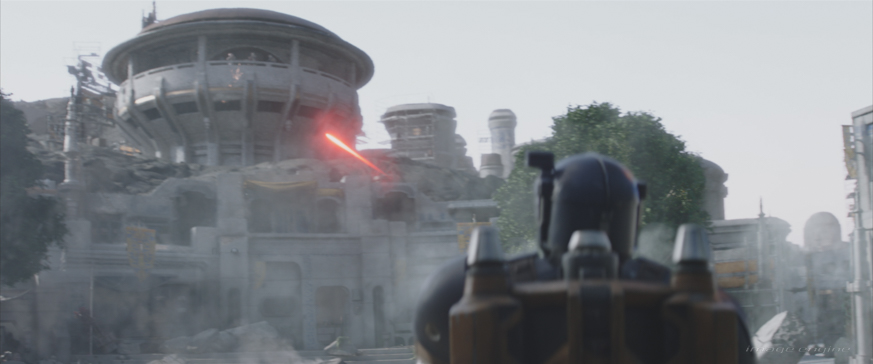
“In general, on a show like The Mandalorian, there’s a lot of shared work to which multiple vendors contribute, especially on large-scale environments. The Pirate was no different,” says Robin. “The challenge here was that the magnitude of the environment asset we were working on was just so large – effectively, the entire city of Nevarro. It must be in the ranks of the largest asset upon which Image Engine has executed. Ultimately, we had to ingest this colossal Nevarro City asset and replicate it to match other vendors’ work.”
Edmond explains that maintaining rigorous organization throughout the collaborative process was crucial to crossing the finish line on the Pirate, particularly during the ingest process. “We ensured we had a lot of back and forth with other vendors on the sequence to ensure total consistency,” he says. “We were often on calls with the other studios to understand the assets they gave us and how they slotted into the sequence. That close working relationship ensured we could deliver high-quality work, even on an asset of this size and complexity.”
Once Image Engine had ingested the Nevarro asset into its shots and started seeing renders, things began to come together quickly, with integration next on the agenda. “We received a variety of plates shot practically on a sound stage built to mimic the Nevarro streets,” says Robin. “It was up to us to digitally extend these shots and ensure they fell off believably into the Nevarro City distance. One structure we had to consider was the Magistrate Tower containing Greef Karga’s offices, which audiences witness from numerous angles. We ensured that whenever the audience saw the tower, from whichever perspective, it felt consistent in its placement from shot to shot.”
Another challenge Robin and his team dealt with on Nevarro involved dealing with smoke. As the sequence occurs amid a battle, many of the plates received were contaminated with the practical smoke captured on set. “When we were extending our shots, we had to do a lot of through the veil of smoke,” says Robin. “And then there was the reverse, where we would receive a shot with no smoke, and we’d have to add the smoke and atmosphere back in to match the sequence’s overall vibe.”
Image Engine also worked on creating the variety of blaster fire that crisscrosses many shots in the Nevarro battle, including the heavy blaster of Paz Vizsla, a notable Mandalorian character the team had worked on in previous seasons. “There were a million blasters that we were responsible for executing on that sequence – thankfully, we’re pretty familiar with implementing Star Wars blasters at this point!” says Robin.
Guns for Hire on Plazir-15
In Chapter 22, Bo-Katan, Dinn, and Grogu venture to the idyllic planet Plazir-15, intending to rendezvous with Bo-Katan’s ex-comrades and bring them back into the Mandalorian fold. However, their journey takes an unexpected detour when the Plazir-15’s rulers solicit the Mandalorian’s skills in pacifying some malfunctioning Imperial and Separatist droids. The request ushers in the sequences featuring Image Engine’s work: Din and Bo-Katan head to the city’s docks, where a Super Battle Droid flees the scene, sparking an exhilarating pursuit through Plazir-15’s streets.
Image Engine’s involvement was comprehensive, encompassing the creation of the dock scenes where Dinn and Bo-Katan encounter the repurposed Super Battle Droids and the Plazir-15 street environments through which the ensuing chase occurs. These two settings, enriched with vibrant dockside waterscapes and streets adorned with neon holograms, called for an array of CG assets, including the droids themselves, landspeeders, and a shot where Din bursts through a glass window to apprehend the rampaging Super Battle Droid.
Although the initial plan for the dock environment called for digitally extending the on-set plates, Image Engine recognized that achieving the desired aesthetic and design of the dockyard required the more comprehensive approach of replacing every element from the original plate with a digital environment, bar Bo-Katan and Din.
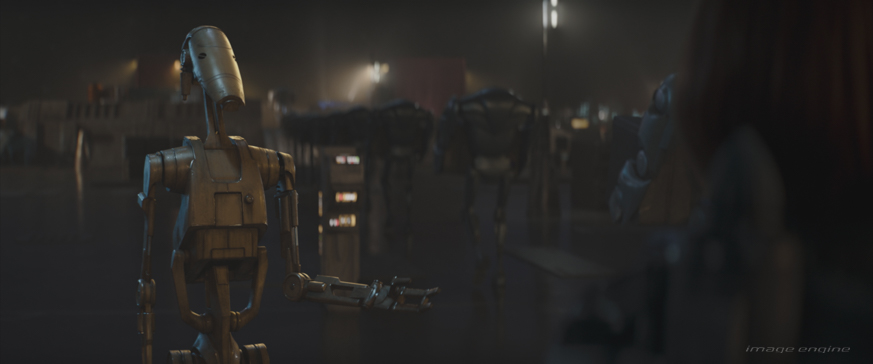
“We completely rotoscoped Din Djarin and Bo-Katan off the dockside plates in their entirety and replaced everything else,” says Robin. “This approach meant we could more realistically integrate the CG droids into the scene (comprising the large, CG Super Battle Droids that are busy unloading and loading the ship and the smaller regular Battle Droid foreman) and have them properly interact with the environment and characters. For example, at one point, Din kicks some of the Super Battle Droids to provoke a reaction. On set, there was nothing real or solid for the actor to interact with – they were kicking thin air. As such, we did things like rotomate Din to understand his placement and relationship to the set and make sure that when he kicked the digital robot asset, he did so in a way that felt believable to the audience.”
Recreating the digital dockside environment also made it easier for Image Engine to reflect characters on the floor or cast light off the walls when blasters fired. “Working with those interactive elements in a digital environment also gave us a little more control to tweak them in Comp after rendering, which ensured high-quality visuals across the sequence,” says Robin.
Of course, digitally recreating the environment also required conceptualizing its appearance. To do so, Image Engine launched into a highly collaborative process with The Mandalorian’s production team.
“We commenced work on the Plazir-15 docks environment using some great artwork supplied by the production, which gave us some pretty good targets concerning what this environment needed to look like,” says Robin. “Using that basis, we created some quick mock-ups of the environment, thinking about things like the aesthetic of the colossal cargo ship the Super Battle Droids are loading and its adjacent environment, its surroundings, and what would proceed into this distance. The production took these designs back from us and put them through their internal concept art department to flush through their ideas and give us even more tangible direction. Our asset department then built the environment assets and the fully rendered environment encapsulating that area of the docks.”
Hot pursuit
As the Plazir-15 dockside scene ends, one of the droids retaliates against Din’s provocations, instigating a chase through the city streets. This pursuit reaches a crescendo when Din propels himself through a plate glass window at the rogue Super Battle Droid.
“As with the docks, we used the production team’s artwork as a guide to create the city streets and populate them with various crowd characters and droids,” says Ryan. “We gave careful care and attention to everything from layout, animation, lighting to compositing to create the expansive streets and render them efficiently within our time window.”
However, when creating the scene, Image Engine didn’t know how the production intended to edit it. The team covered all bases by laying out its 3D street assets so they could be rendered from any viewpoint. This approach gave Image Engine a starting point to block the shots and the flexibility to adapt to cinematographic changes.
“The sequence doesn’t take place in a single street, so early on, we deciphered how many streets the characters run down, how many buildings we’d have to build to accommodate that, and so on,” says Robin. “For example, how many buildings would we need to accommodate all these different views of the far-flung city? What assets would we need to create to make the streets feel alive? All these facets of the work on the Plazir-15 cityscape needed determining. Once we had sign-off from the production on our approach, the assets team started to design the detail in the buildings, the architecture, and all the other elements involved in those environment builds.”
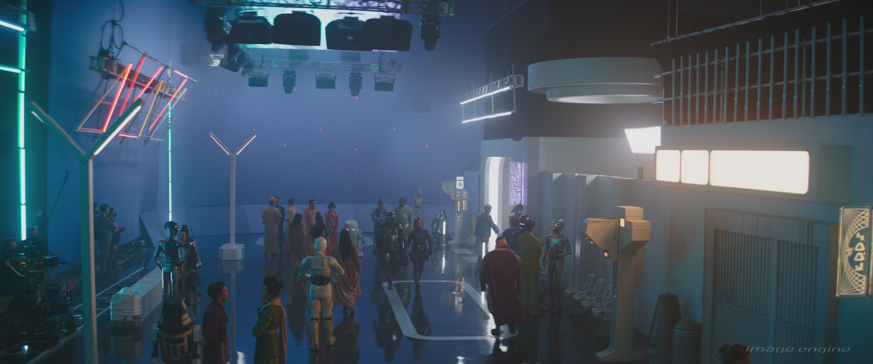
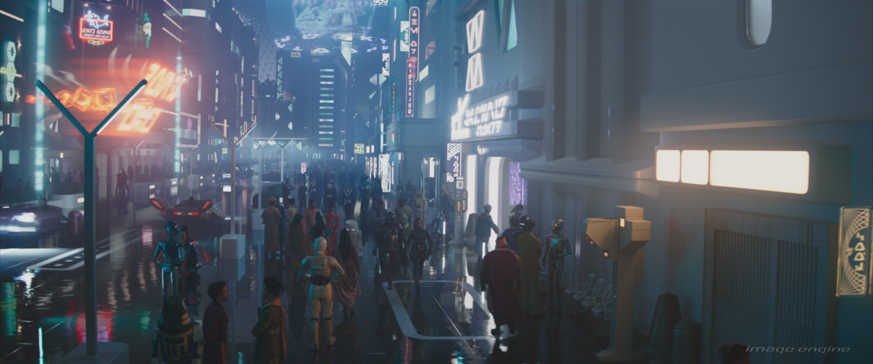
Some of these assets included the abundance of secondary actors filling up the streets, including multiple robots. “As with the Plazir docks, we needed to rotoscope every actor in every plate to support us when integrating them back into our full-CG environments, complete with reflections in the floor and a night sky above,” says Robin. “Once layout and lighting were well underway, we just needed renders from compositing to start the integration process and make the necessary decisions to ensure everything looked as good as possible.
“All in all, creating Plazir-15’s streets was a very interconnected process. The circular approach of getting everything through all the departments and then going back and elaborating on the assets, the layout, and other processes/departments to ensure things were of the highest possible quality helped bring the sequence together.”
To cap off the scene, Din launches himself through a window, tackling the Super Battle Droid and bringing the chase to a close. “This shot started with a plate and a stunt double in place for the Super Battle Droid and another for Din jumping through the window to tackle them,” says Ryan. “Again, the plate was a useful reference, but we kept only a small section of the environment and some crowd extras. The remainder of the scene was completely replaced, with animation handling the characters’ interaction and FX simulating the breaking glass.”
Returning to Mandalore
In Chapter 24, the climactic finale of The Mandalorian’s third season, Bo-Katan and her scout team attempt to withdraw from Moff Gideon’s stronghold following an unexpected ambush from Gideon’s formidable, beskar-clad stormtroopers. Concurrently, with Grogu’s aid, Din Djarin embarks on a mission to confront Gideon.
Image Engine’s contributions to the episode were many and varied. The team worked on several environment shots comprising the verdant, greenery-filled mines beneath Mandalore, the fierce clash between jetpack-equipped beskar troopers and the Mandalorian covert, and Din’s maneuvering towards Moff Gideon through a series of sequentially deactivating energy gates, eliminating stormtroopers as he goes.
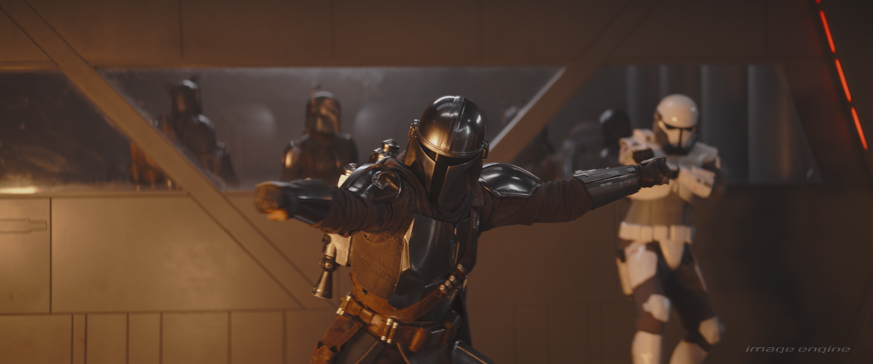


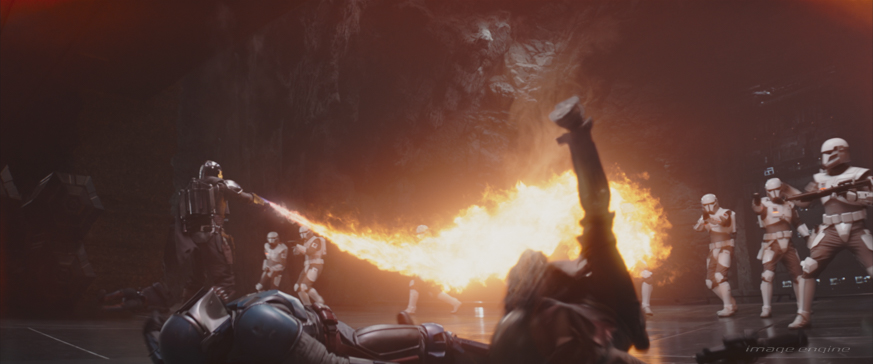
“The initial approach to creating the red laser-gate barricades leading to Moff Gideon’s HQ was to concept it in compositing, as the sequence was an organically evolving piece of design,” remembers Gabriel. “To build the look of the red laser gates, we used reference look tests provided by the production and looked at the same effect in Star Wars: The Phantom Menace. We tried a variety of different styles with different textures and opacities.”
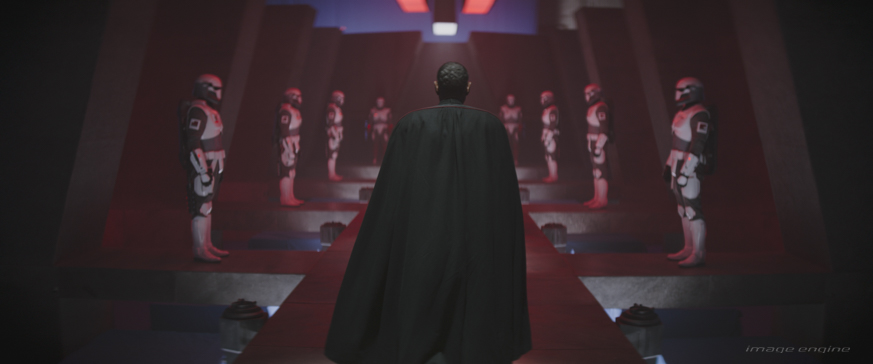
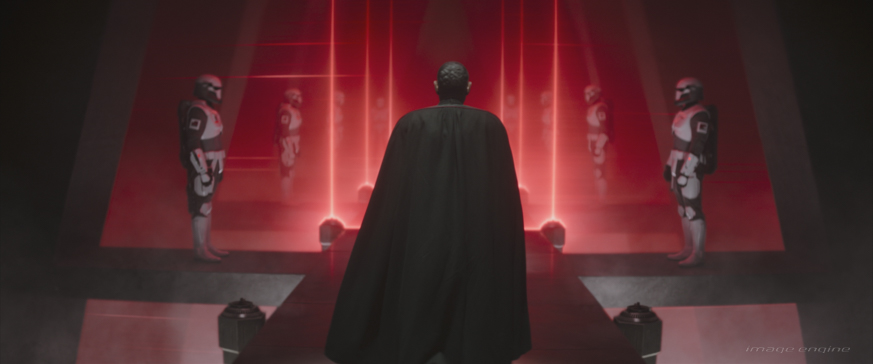
Gabriel and his team pre-planned the layering of the laser gates and executed rotoscoping to help facilitate the process. “With the help of some layout geo and comp geo, we were able to generate a combination of passes and masks that allowed us to tweak the effect and bring it to life. It was particularly challenging as the environment was pretty dark, requiring us to work on more-visible interactions to make everything look authentic. The sequence also had a lot of atmospherics that we had to include, enhance, and relight. Regardless, the team did brilliant work on a stunning moment in the episode.”
As for the underground caves where the Mandalorians take shelter, Image Engine created yet another digital environment: a natural cavern structure with walls entangled in vines and moss.
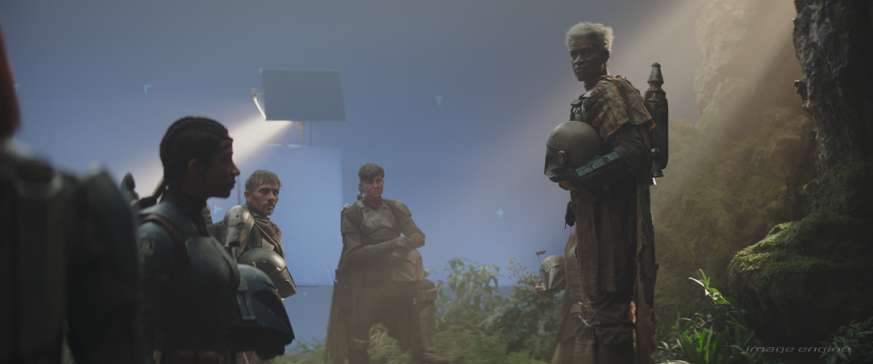
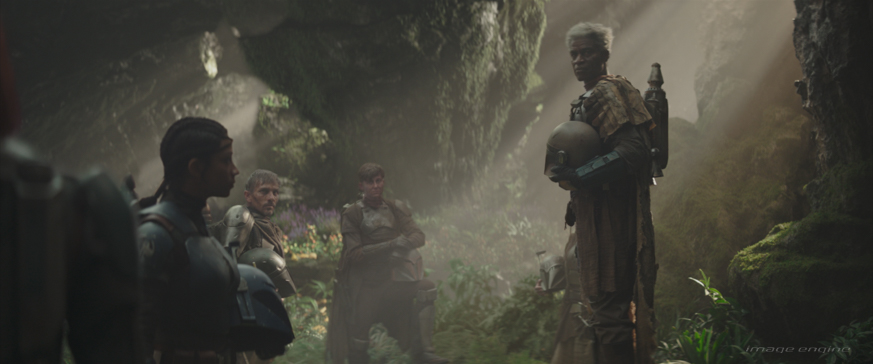
“The production provided us with some initial concept designs as a starting point for the caves, alongside on-set Lidar scans of the environment, which we used as our base for the rock formations and the cave’s materials,” says Barry.
Once Image Engine had a solid layout, the next step was to incorporate the lush vegetation and water elements that were key story points and then light the cave. “The lighting in the interior of the cave was key in creating the look of the environment, with god rays poking through the cave openings and illuminating certain areas within,” says Ryan.
Another shot Image Engine contributed to Chapter 24 of The Mandalorian comprises a beautiful shot of the Mandalorians jetpacking over the surface of their charred planet. “This was one of my favourite shots set on Mandalore, with the Mandalorians flying out of the cave environment and revealing the planet’s surface,” adds Ryan. “Lots of care and attention went into creating the dramatic-looking surface of Mandalore, with large craters and huge ground spike formations where the ground has caved in. We also put great effort into lighting the planet’s surface material to communicate its almost glass-like quality.”
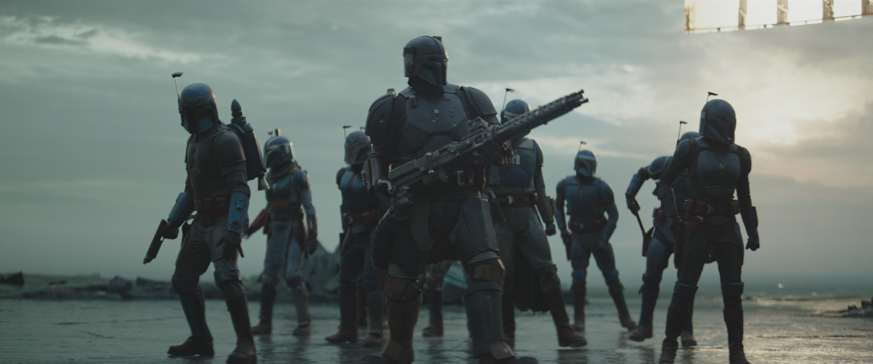

Relighting the Forge
And finally, to cap off Image Engine’s contributions to The Mandalorian is one of Chapter 24’s – and the season’s – most symbolic, in which Bo-Katan reignites the grand Mandalorian forge. Its blue flames blaze defiantly, heralding a rebirth for the Mandalorians and their reclaimed home world.
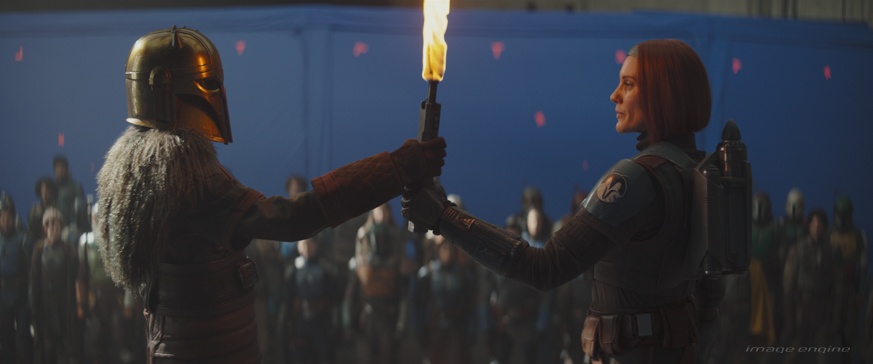
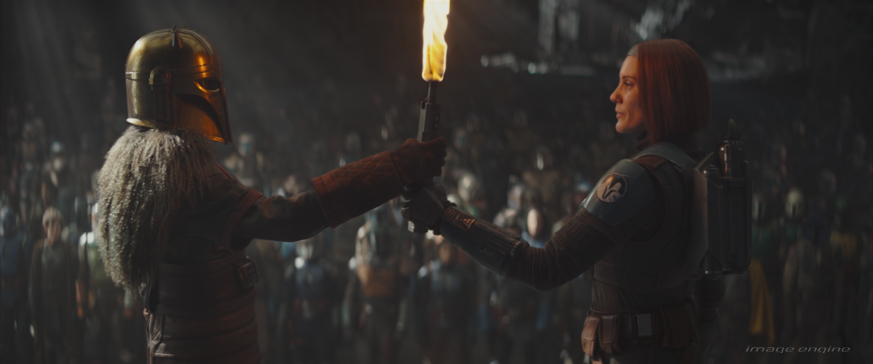
“The immense scale of the ancient Mandalore Forge environment and its importance to the Mandalorians made this a significant build, requiring much thought and effort. We added crowds to fill out the on-set actors to give the feel of a more extensive gathering of the remaining Mandalorians,” says Ryan. “We also paid a lot of attention to the details: the Forge is still damaged from the previous battle but has some elements rebuilt, and additional assets like flags draping from walls indicate the Mandalorians are starting to reclaim their home.”
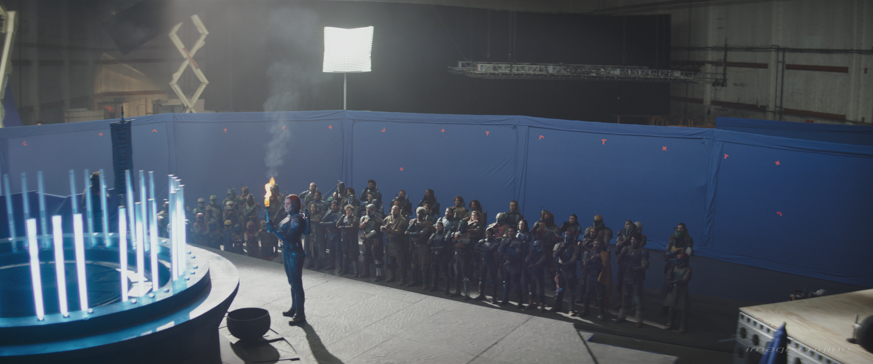
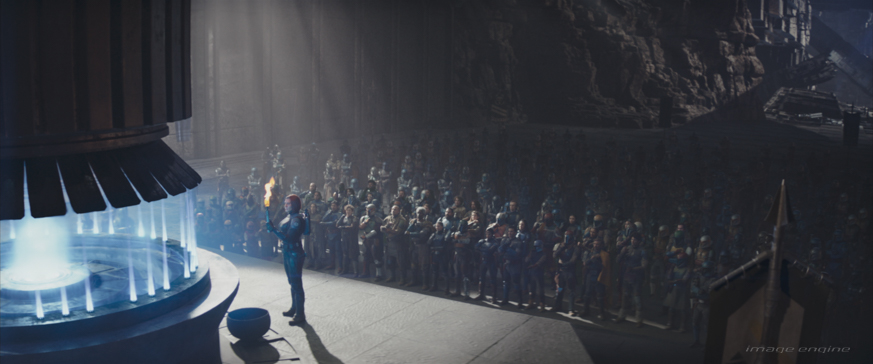
For the flames themselves, Image Engine needed to match the specific look of the smaller forge flames seen in earlier seasons and episodes, but on a much larger scale. “FX and Comp did a fantastic job of helping to develop the look and timing of the actual flame to match just what the production wanted to see,” says Ryan.
“It took a lot of teamwork and determination to complete the environment,” adds Barry. “The final result is something we’re proud of and feel lucky to have been a part of!”
This is the way
And so another chapter closes on the adventures of Din and Grogu. And from the detailed rendering of Coruscant and Plazir-15 to the dramatic portrayals of Din’s encounters with multiple enemies, Image Engine’s contributions continue to shine, enhancing the series’ storytelling, adventure, and world-building.
“Over the years we’ve spent working with The Mandalorian production team, a deep trust has grown between us and them, which I think is reflected in the type, size, and scope of the work we do,” says Cara. “Our communication with the production is rock solid – we’re never unclear on what they expect or the direction we need to go – and we couldn’t ask for a better production team to work with. The quality of our relationship is certainly mirrored in the work we produce in collaboration.”
“I feel incredibly proud of the work from all the departments on the show and what they achieved,” adds Ryan. “There was a huge variety of work to tackle on The Mandalorian season three, and some big challenges in every sequence. Even so, everyone at Image Engine maintained a great attitude throughout. The Mandalorian season three felt like a great team effort. I can’t wait to see where Din and Grogu go from here.”

